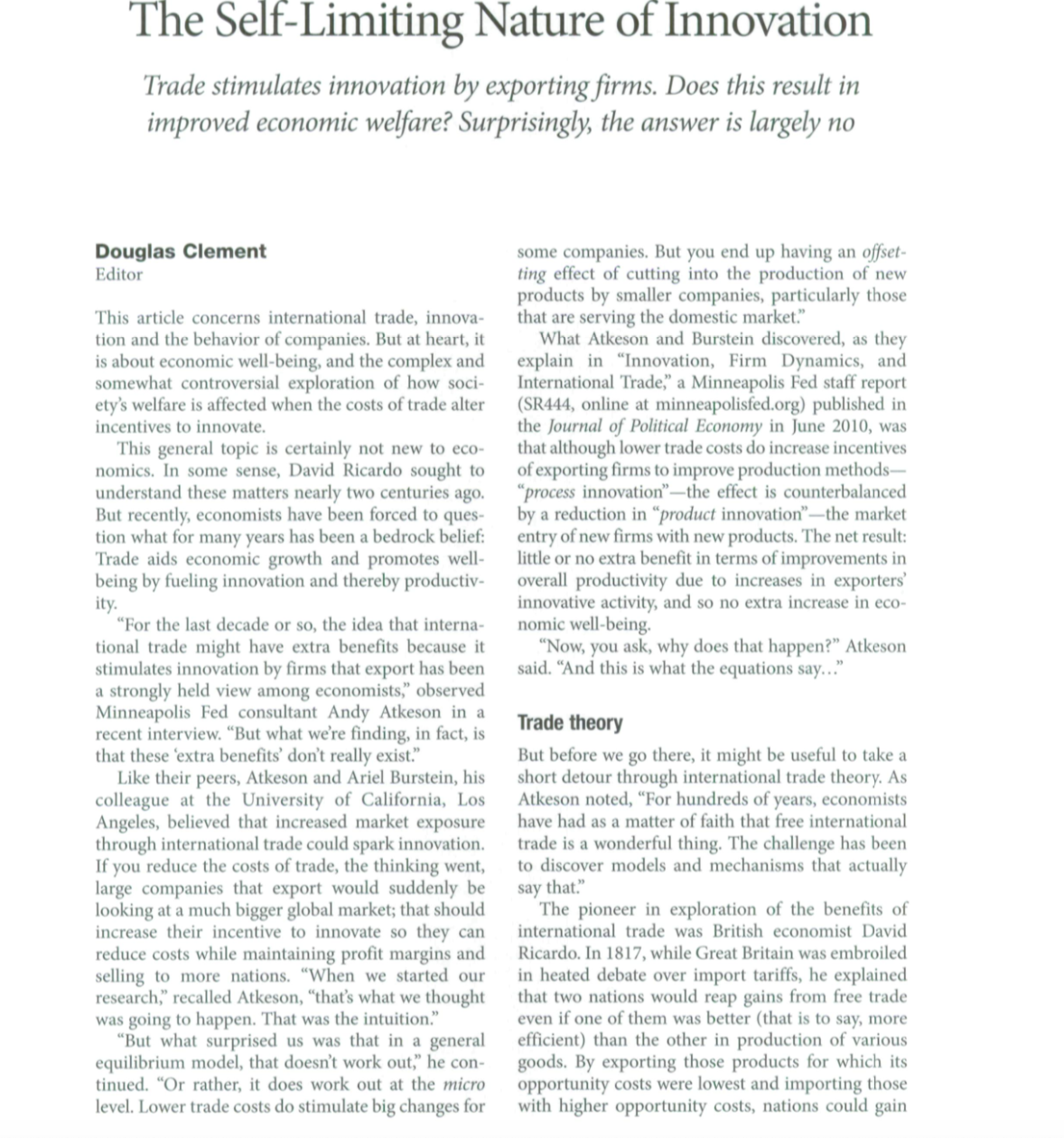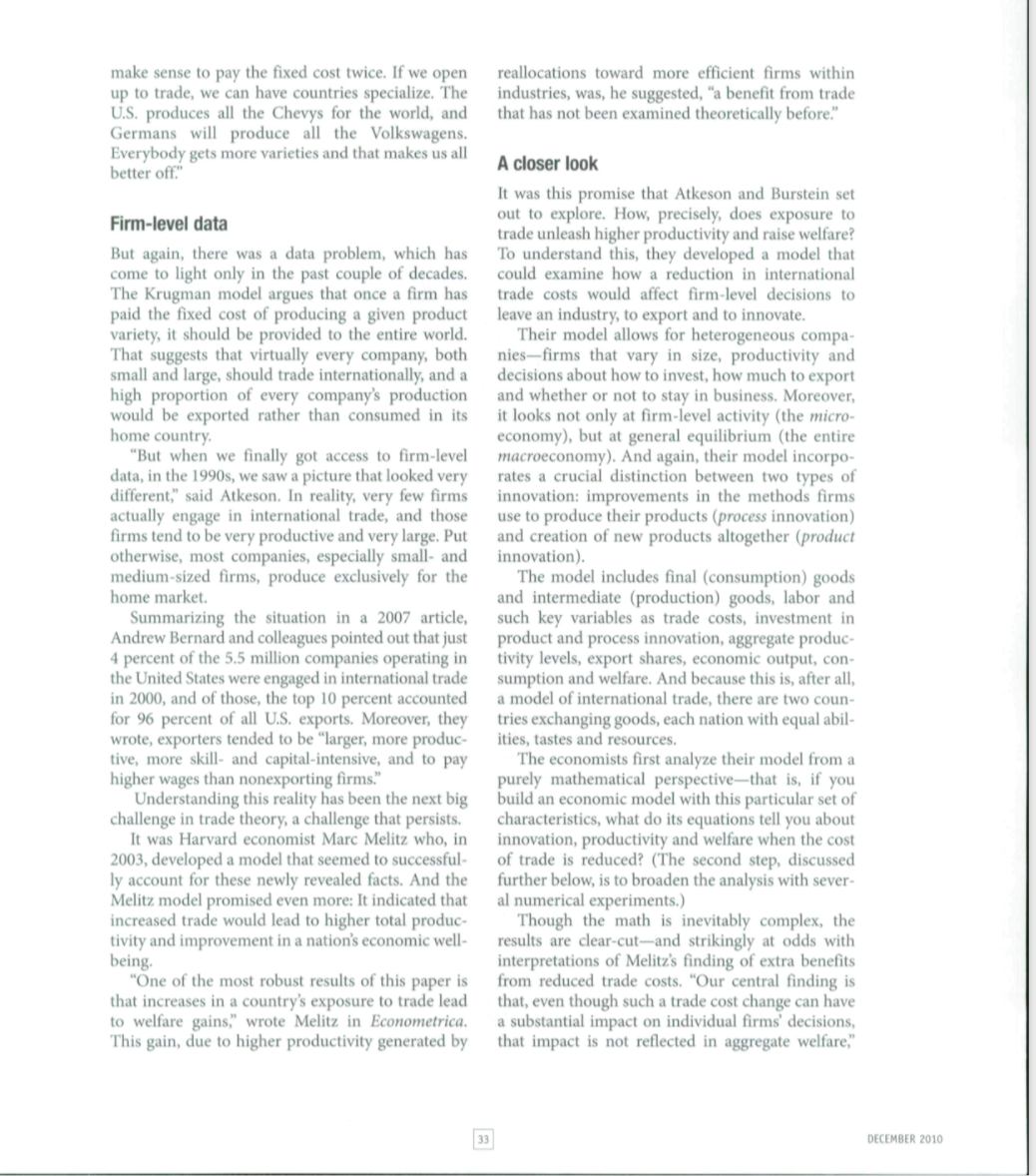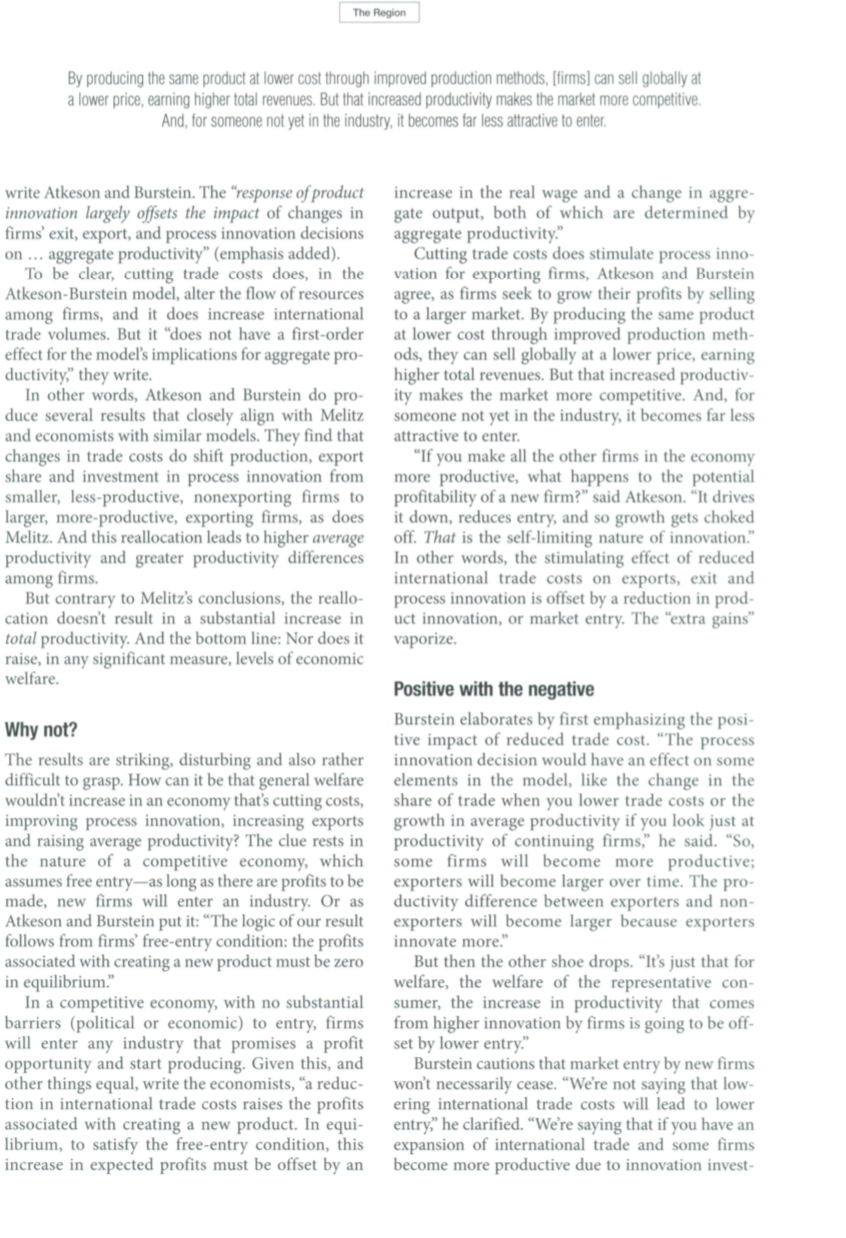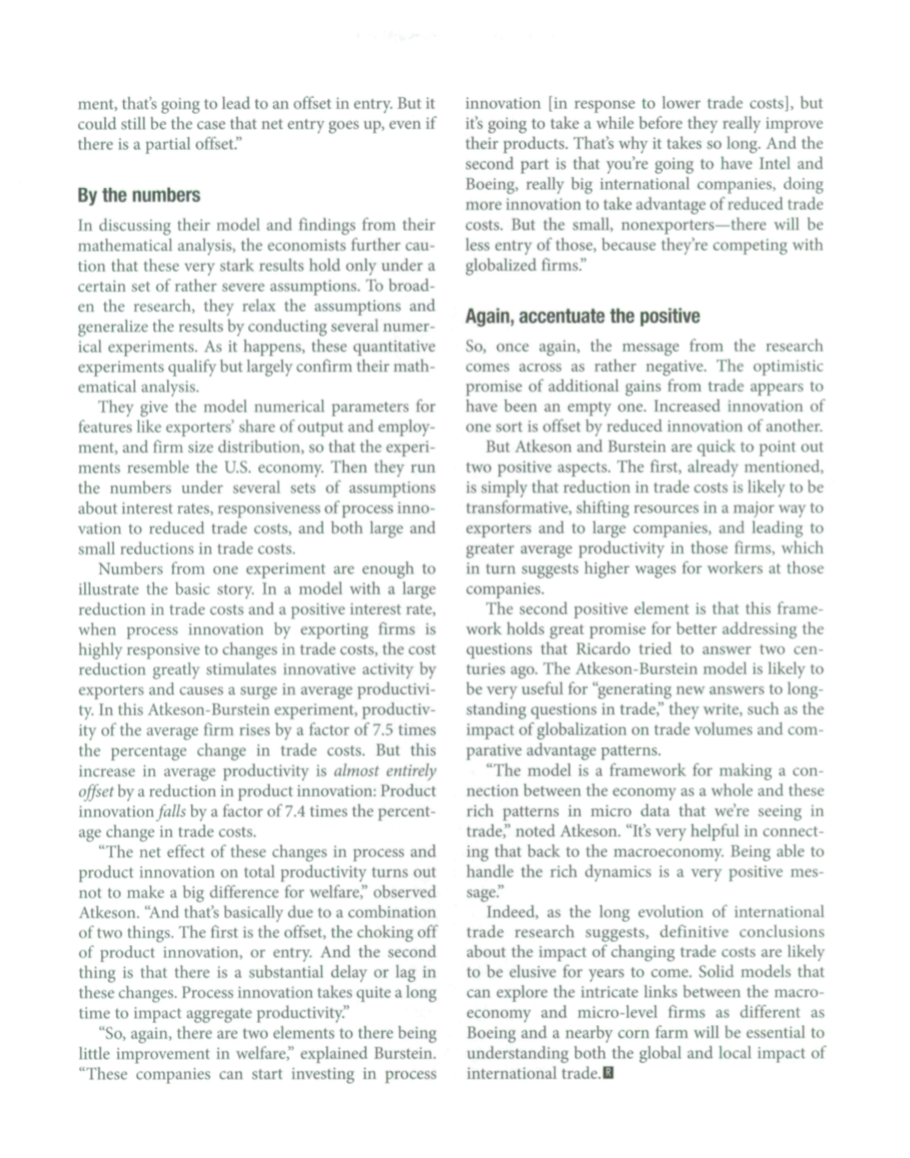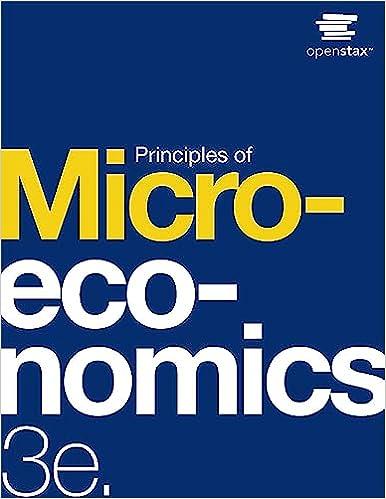The Self-Limiting Nature of Innovation Trade stimulates innovation by exporting rms. Does this result in improved economic welfare? Surprisingly the answer is largely no Douglas Clement Editor This article concerns international trade. innova- tion and the behavior of companies. But at heart. it is about economic well-being, and the complex and somewhat controversial exploration of how soci- ety's welfare is affected when the costs of trade alter incentives to innovate. This general topic is certainly not new to eco nomics. in some sense. David Ricardo sought to understand these matters nearly two centuries ago. But recently. economists have been forced to ques- tion what for many years has been a bedrock belief: Trade aids economic growth and promotes well- being by fueling innovation and thereby productiv- ity. \"For the last decade or so. the idea that interna- tional trade might have extra benefits because it stimulates innovation by rms that export has been a strongly held view among economists.\" observed Minneapolis Fed consultant Andy Atkeson in a recent interview. \"But what we're nding. in fact. is that these 'extra benets' don't really exist." Like their peers. Atkeson and Ariel Burstein. his colleague at the University of California. Los Angeles. believed that increased market exposure through international trade could spark innovation. If you reduce the costs of trade, the thinking went, large companies that export would suddenly be looking at a much bigger global market; that should Increase their incentive to innovate so they can reduce costs while maintaining profit margins and selling to more nations. \"When we started our research." recalled Atkeson. \"that's what we thought was going to happen. That was the intuition.\"l \"But what surprised us was that in a general equilibrium model. that doesn't work out." he con- tinued. \"Or rather. it does work out at the micro level. Lower trade costs do stimulate big changes for some companies. But you end up having an orset- ting effect of cutting into the production of new products by smaller companies. particularly those that are serving the domestic market.\" What Atkeson and Burstein discovered. as they explain in \"Innovation, Firm Dynamics. and International Trade." a Minneapolis Fed staff report ($11444. online at minneapolisfedorg) published in the Journal of Political Economy in lune 2010. was that although lower trade costs do increase incentives of exporting rms to improve production methods "process innovation\"the effect is counterbalanced by a reduction in \"product innovation\"the market entry of new rms with new products. The net result: little or no extra benet in terms of improvements in overall productivity due to increases in exporters' innovative activity, and so no extra increase in eco- nomic well-being. \"Now. you ask, why does that happen?\" Atkeson said. \"And this is what the equations say...\" Trade literary But before we go there. it might be useful to take a short detour through international trade theory. As Atkeson noted. \"For hundreds of years. economists have had as a matter of faith that free international trade is a wonderful thing. The challenge has been to discover models and mechanisms that actually say that.\" The pioneer in exploration of the benets of international trade was British economist David Ricardo. In 1817. while Great Britain was embroiled in heated debate over import tariffs. he explained that two nations would reap gains from free trade even if one of them was better (that is to say. more efficient) than the other in production of various goods. By exporting those products for which its opportunity costs were lowest and importing those with higher opportunity costs. nations could gain The Region "For hundreds of years, economists have had as a matter of faith that free international trade is a wonderful thing. The challenge has been to discover models and mechanisms that actually say that." from trade. It was a concept he termed "comparative Paul Krugman, in a celebrated 1980 article. "A new advantage."(Another British economist, Robert framework for analyzing trade is needed." Torrens, actually described the idea two years Krugman's theory, for which he received the before Ricardo, in "An Essay on the External Corn Nobel prize in 2008, addressed this need by recog Trade.") nizing that economies of scale are crucial in pro- The notion was based largely on technological duction (and trade) decisions. "When ... economies differences. Even if Portugal had technology that of this kind are allowed to trade," he wrote, "increas gave it an absolute advantage over, say, England, in ing returns produce trade and gains from trade even production of textiles and wine, both nations would benefit from exporting those goods at which it was if the economies have identical tastes, technology, and factor endowments." relatively more efficient. So, in this example, The crucial elements of Krugman's model were England would be better off exporting cloth to Portugal and importing wine if its opportunity cost product differentiation and competition among for textile production were lower than for wine. firms with some level of monopoly power (so-called monopolistic competition). So, for example, Jettas For a more complete explanation, see and Chevys are the same type of product (both "Comparative advantage: Powerful, but not obvious" automobiles), but they're different. Volkswagen has in the December 2002 Region at minneapolisfed.org.) a monopoly in producing Jettas, while General The next generation of trade models, developed Motors has a monopoly on Chevys. in the early 1900s initially by Eli Heckscher and subsequently by Bertil Ohlin, his student, was simi- And this is where economies of scale (or increas ing returns) come in. Once GM has invested mil- lar to Ricardo's, but relied more on factor endow- lions in producing the Chevrolet, and Volkswagen ments than technological differences. The Swedish has done the same for building Jettas, it's more effi- economists showed that, given its endowments of cient for them to specialize in those activities. It capital and labor, a country like the United States, for instance, would be a relatively low-cost location would be far too costly for GM (or Volkswagen) to build both Chevys and Jettas; far more efficient for for producing and exporting goods that needed physical capital and skilled labor. China, on the a company to specialize in one variety of car and other hand, would be better suited for the produc- then trade according to tastes. tion and export of goods requiring lots of unskilled "The Krugman model is essentially that," labor. Trade flows of dissimilar products between observed Atkeson. "Each manufacturer pays this fixed cost to start producing a variety, and it doesn't nations with disparate factor endowments would therefore be the optimal pattern. Powerful as it was, the Heckscher-Ohlin model In Brief 'soon ran into a problem with the data," noted Atkeson. "Most trade is actually between countries A trade mirage that are similar in their levels of development." And much of that trade consists of similar products. For Economists have long thought that international trade- beneficial in many respects-might have the "extra bene- instance, the United States and Germany trade sig- fit" of stimulating innovation by exporting firms, and nificant quantities of cars, shipping Fords or thereby fueling productivity and overall economic growth. Chevrolets eastward across the Atlantic and sending Volkswagens and BMWs in the opposite direction. . Recent research suggests, however, that such benefits are Existing trade theory couldn't account for this. negligible or nonexistent at the macroeconomic level. While trade does appear to stimulate improvements in production methods (process innovation) by exporting firms, it also Increasing returns diminishes product innovation by smaller companies pri- marily serving domestic markets. Neither the extensive trade among the industrial countries, nor the prevalence in this trade of two- . The net result: little or no gain in overall productivity due way exchanges of differentiated products, make to increases in exporters' innovative activity, and therefore much sense in terms of standard theory," observed no "extra" increase in economic well-being from interna- tional trade.make sense to pay the fixed cost twice. if we open up to trade. we can have countries specialise. The US. produces all the Chevys for the world. and Germans will produce all the Voiltswagens. Everybody gets more varieties and that makes us all better off." Willie Iut again. there was a data problem. which has come to light only in the past couple of decades. The Knigman model argues that once a rm has paid the fixed cost of producing a given product variety. it should be provided to the entire world. That suggests that virtually every company. both small and large. should trade internationally. and a high proportion of every companfs production would be exported rather than consumed in its home country. \"But when we nally got access to firm-level data. in the 19905, we saw a picture that looked very different." said Atkeson. In reality. very few rms actually engage in international trade. and those firms tend to be very productive and very large. Put otherwise. most companies. especially small- and medium-sized rms, produce exclusively for the home market. Summarizing the situation in a 2007 article. Andrew Bernard and colleagues pointed out that just 4 percent of the 5.5 million companies operating in the United States were engaged in international trade in 2000. and of those. the top 10 percent accounted for 96 percent of all US. exports. Moreover. they wrote. exporters tended to be "larger. more produc- tive. more skilb and capital-intensive. and to pay higher wages than nonerporting rms." Understanding this reality has been the next big challenge in trade theory. a challenge that persists. It was Harvard economist Marc Melitz who. in 2003. developed a model that seemed to successful- ly account for these newly revealed facts. And the Melitz model promised even more: It indicated that increased trade would lead to higher total produc- tivity and improvement in a nation's economic well- being. \"One of the most robust results of this paper is that increases in a country's exposure to trade lead to welfare gains." wrote Melita in Econometrica. This gain. clue to higher productivity generated by lBl reallocations toward more efcient rms within industries. was. he suggested. \"a benet from trade that has not been examined theoretically before." Adoseriook It was this promise that Atkeson and Burstein set out to explore. How. precisely. does exposure to trade unleash higher productivity and raise Welfare? To understand this. they developed a model that could examine how a reduction in international trade costs would affect firm-level decisions to leave an industry. to export and to innovate. Their model allows for heterogeneous compa- niesrms that vary in size. productivity and decisions about how to invest. how much to export and whether or not to stay in business. Moreover. it looks not only at firm-level activity (the micro- economy}. but at general equilibrium (the entire macroeconomy). And again, their model incorpo- rates a crucial distinction between two types of innovation: improvements in the methods firms use to produce their products {process innovation} and creation of new products altogether (product innovation). The model includes final (consumption) goods and intermediate (production) goods. labor and such key variables as trade costs. investment in product and process innovation. aggregate produc- tivity levels, export shares. economic output. con- sumption and welfare. And because this is. after all. a model of international trade. there are two coun- tries exchanging goods. each nation with equal abil- ities. tastes and resources. The economists first analyze their model from a purely mathematical perspectivethat is. if you build an economic model with this particular set of characteristics. what do its equations tell you about innovation. productivity and welfare when the cost of trade is reduced? (The second step. discussed trther below. is to broaden the analysis with sever- al numerical experiments) Though the math is inevitably complex. the results are dear-cutmand strikingly at odds with interpretations of Melits's nding of extra benets from reduced trade costs. \"Our central nding is that. even though such a trade cost change can have a substantial impact on individual firms' decisions. that impact is not reected in aggregate welfare." DEEENEEI 2010 The Region By producing the same product at lower cost through improved production methods, [firms] can sell globally at a lower price, earning higher total revenues. But that increased productivity makes the market more competitive. And, for someone not yet in the industry, it becomes far less attractive to enter. write Atkeson and Burstein. The "response of product increase in the real wage and a change in aggre- innovation largely offsets the impact of changes in gate output, both of which are determined by firms' exit, export, and process innovation decisions aggregate productivity." on ... aggregate productivity" (emphasis added). Cutting trade costs does stimulate process inno- To be clear, cutting trade costs does, in the Atkeson-Burstein model, alter the flow of resources vation for exporting firms, Atkeson and Burstein agree, as firms seek to grow their profits by selling among firms, and it does increase international trade volumes. But it "does not have a first-order to a larger market. By producing the same product effect for the model's implications for aggregate pro- at lower cost through improved production meth- ods, they can sell globally at a lower price, earning ductivity," they write. In other words, Atkeson and Burstein do pro- higher total revenues. But that increased productive ity makes the market more competitive. And, for duce several results that closely align with Melitz and economists with similar models. They find that someone not yet in the industry, it becomes far less attractive to enter. changes in trade costs do shift production, export "If you make all the other firms in the economy share and investment in process innovation from more productive, what happens to the potential smaller, less-productive, nonexporting firms to profitability of a new firm?" said Atkeson. "It drives larger, more-productive, exporting firms, as does Melitz. And this reallocation leads to higher average it down, reduces entry, and so growth gets choked off. That is the self-limiting nature of innovation." productivity and greater productivity differences In other words, the stimulating effect of reduced among firms. But contrary to Melitz's conclusions, the reallo- international trade costs on exports, exit and process innovation is offset by a reduction in prod- cation doesn't result in a substantial increase in total productivity. And the bottom line: Nor does it uct innovation, or market entry. The "extra gains" vaporize. raise, in any significant measure, levels of economic welfare. Positive with the negative Why not? Burstein elaborates by first emphasizing the posi- tive impact of reduced trade cost. "The process The results are striking, disturbing and also rather innovation decision would have an effect on some difficult to grasp. How can it be that general welfare elements in the model, like the change in the wouldn't increase in an economy that's cutting costs, share of trade when you lower trade costs or the improving process innovation, increasing exports and raising average productivity? The clue rests in growth in average productivity if you look just at the nature of a competitive economy, which productivity of continuing firms," he said. "So, some firms will become more productive; assumes free entry-as long as there are profits to be exporters will become larger over time. The pro- made, new firms will enter an industry. Or as ductivity difference between exporters and non- Atkeson and Burstein put it: "The logic of our result exporters will become larger because exporters follows from firms' free-entry condition: the profits innovate more." associated with creating a new product must be zero But then the other shoe drops. "It's just that for in equilibrium." In a competitive economy, with no substantial welfare, the welfare of the representative con- barriers (political or economic) to entry, firms sumer, the increase in productivity that comes from higher innovation by firms is going to be off- will enter any industry that promises a profit set by lower entry." opportunity and start producing. Given this, and Burstein cautions that market entry by new firms other things equal, write the economists, "a reduc- won't necessarily cease. "We're not saying that low- tion in international trade costs raises the profits ering international trade costs will lead to lower associated with creating a new product. In equi- entry," he clarified. "We're saying that if you have an librium, to satisfy the free-entry condition, this increase in expected profits must be offset by an expansion of international trade and some firms become more productive due to innovation invest-ment, that's going to lead to an offset in entry. But it innovation [in response to lower trade costs], but could still be the case that net entry goes up, even if it's going to take a while before they really improve there is a partial offset." their products. That's why it takes so long. And the second part is that you're going to have Intel and By the numbers Boeing, really big international companies, doing In discussing their model and findings from their more innovation to take advantage of reduced trade costs. But the small, nonexporters-there will be mathematical analysis, the economists further cau- tion that these very stark results hold only under a less entry of those, because they're competing with certain set of rather severe assumptions. To broad- globalized firms." en the research, they relax the assumptions and generalize the results by conducting several numer- Again, accentuate the positive ical experiments. As it happens, these quantitative So, once again, the message from the research experiments qualify but largely confirm their math- comes across as rather negative. The optimistic ematical analysis. They give the model numerical parameters for promise of additional gains from trade appears to features like exporters' share of output and employ- have been an empty one. Increased innovation of one sort is offset by reduced innovation of another. ment, and firm size distribution, so that the experi- But Atkeson and Burstein are quick to point out ments resemble the U.S. economy. Then they run two positive aspects. The first, already mentioned, the numbers under several sets of assumptions is simply that reduction in trade costs is likely to be about interest rates, responsiveness of process inno- transformative, shifting resources in a major way to vation to reduced trade costs, and both large and exporters and to large companies, and leading to small reductions in trade costs. Numbers from one experiment are enough to greater average productivity in those firms, which illustrate the basic story. In a model with a large in turn suggests higher wages for workers at those companies. reduction in trade costs and a positive interest rate, The second positive element is that this frame- when process innovation by exporting firms is highly responsive to changes in trade costs, the cost work holds great promise for better addressing the questions that Ricardo tried to answer two cen- reduction greatly stimulates innovative activity by turies ago. The Atkeson-Burstein model is likely to exporters and causes a surge in average productivi ty. In this Atkeson-Burstein experiment, productive be very useful for "generating new answers to long- ity of the average firm rises by a factor of 7.5 times standing questions in trade," they write, such as the impact of globalization on trade volumes and com- the percentage change in trade costs. But this increase in average productivity is almost entirely parative advantage patterns. "The model is a framework for making a con- offset by a reduction in product innovation: Product innovation falls by a factor of 7.4 times the percent- nection between the economy as a whole and these rich patterns in micro data that we're seeing in age change in trade costs. "The net effect of these changes in process and trade," noted Atkeson. "It's very helpful in connect- ing that back to the macroeconomy. Being able to product innovation on total productivity turns out not to make a big difference for welfare," observed handle the rich dynamics is a very positive mes- sage." Atkeson. "And that's basically due to a combination Indeed, as the long evolution of international of two things. The first is the offset, the choking off of product innovation, or entry. And the second trade research suggests, definitive conclusions about the impact of changing trade costs are likely thing is that there is a substantial delay or lag in to be elusive for years to come. Solid models that these changes. Process innovation takes quite a long can explore the intricate links between the macro- time to impact aggregate productivity." "So, again, there are two elements to there being economy and micro-level firms as different as Boeing and a nearby corn farm will be essential to little improvement in welfare," explained Burstein. "These companies can start investing in process understanding both the global and local impact of international trade
